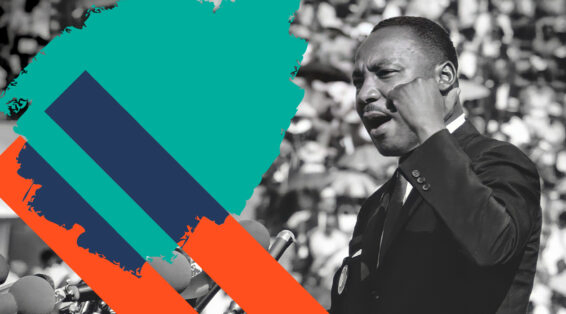Your Genesys Blog Subscription has been confirmed!
Please add genesys@email.genesys.com to your safe sender list to ensure you receive the weekly blog notifications.
Subscribe to our free newsletter and get blog updates in your inbox
Don't Show This Again.

On January 15th, 1981, when I was just seven years old, my then-favorite singer, Stevie Wonder, performed a concert at the National Mall in Washington, D.C. It was the culmination of Wonder’s multiyear efforts to get a bill that had stalled in Congress signed into law — one that formally recognized Dr. Martin Luther King Jr.’s birthday as a national holiday. The concert, held on a snowy day in D.C., was attended by many civil rights luminaries and more than 100,000 others.
Wonder’s stardom and unceasing efforts were the catalyst for a national debate that ultimately culminated in the declaration of a national holiday, signed into law by President Ronald Reagan, and enacted formally in 1986. In that signing, and the national conversation that accompanied it, there was more than a hint of reductionism that continues to this day. The myriad ways in which Dr. King was a humanitarian have been largely overshadowed in popular culture by the sound bites that everyone knows.
“I have a dream that my four little children will one day live in a nation where they will not be judged by the color of their skin, but by the content of their character,” is the singular MLK quote that’s referenced annually. But his work was far more nuanced and expansive. His was, as he desired it to be remembered, “a committed life.”
Dr. King was born in 1929; he was the son of a prominent Christian minister. His father was also a very early civil rights activist, leading Black Atlantans in marches for civil rights in the 1930s. Like his father, King attended Atlanta’s Morehouse College, beginning his studies there as a prodigious 15-year old. He graduated with a BA in Sociology at the age of 19. After completing his studies at Morehouse, King obtained his Doctorate in Theology from Boston University in 1955.
By the time he completed his studies, Dr. King had married Coretta Scott. They soon started a family and had four children. And he started his life as an activist almost immediately after returning to the South from seminary school. He was launched into national prominence when he organized and led the Montgomery Bus Boycott in 1955, an event that began in the wake of Rosa Parks’ arrest after she refused to give up her seat to a white passenger.
While the Montgomery Bus Boycott made him a national name, it also introduced many in the US to the idea of nonviolent protest. Even though King’s house was bombed, and he was arrested during the 385-day boycott, the boycott was a litmus test for the efficacy of the nonviolent movement in the South.
King subsequently formed the Southern Christian Leadership Conference (SCLC) in 1957 with other civil rights trailblazers. Over the following years, he continued to deploy nonviolent protests, based on the teachings of Gandhi in India. He protested for a broad array of societal issues, including voting rights, desegregation, labor rights and more. These protests were, collectively and individually, masterstrokes of strategy that reverberated across the South, throughout the nation and around the world. King used precision tactics and specific targets to change the optics of segregation for an increasingly televised audience as he pushed for what he initially termed a “second emancipation proclamation” from then President John F. Kennedy. Atlanta. Birmingham. Selma. The March on Washington. King was the face of the movement for a decade. President Lyndon Johnson’s passage of the Civil Rights Act of 1964 and the Voting Rights Act of 1965 were the crowning achievements to come from this 10-year struggle.
As the second half of the 60s began, King’s influence grew nationally and internationally. Consequentially, his worldview also evolved greatly during the last three years of his life. While King saw the link between the struggle for civil rights for Black people in the US to global brotherhood, increasingly, he also came to see class and economic justice as a defining component of a broader struggle for equality.
The Poor People’s Campaign, launched in early 1968, would be his final moment in the national spotlight. King’s last book, “Where Do We Go from Here: Chaos or Community,” laid out his blueprint for how to address the connection between social issues and poverty. He planned to travel the country, assembling a multiracial “army of the poor” to march on Washington and demand an “economic bill of rights.” The idea of guaranteed basic income was one of the cornerstones of this movement.
King was assassinated on the balcony of the Lorraine Motel in Memphis, TN, on April 4th, 1968. His legacy has only grown since his death. King’s impact could be felt in places like South Africa and Ireland — the fight for civil rights further globalized after his death.
At Genesys, we, too, are looking toward his teachings to inform structural change. It’s indeed an honor to begin our second year of diversity, equity and inclusion initiatives — and to feel his imprint on our efforts as we take a holiday to remember him.
There’s a direct line from his life’s work and our efforts to create systemic change at Genesys. This will manifest in our dismantling of traditional systems that perpetuate inequality for marginalized groups. This will manifest in being more intentional with our hiring and promotion efforts to address representation gaps for women and underrepresented groups. This will manifest in establishing new practices and behaviors to promote change and build a more equitable and inclusive culture at Genesys.
This is the work we’re doing. And this is what it means to “live a committed life.” I suspect that Dr. King would approve.
Subscribe to our free newsletter and get blog updates in your inbox.